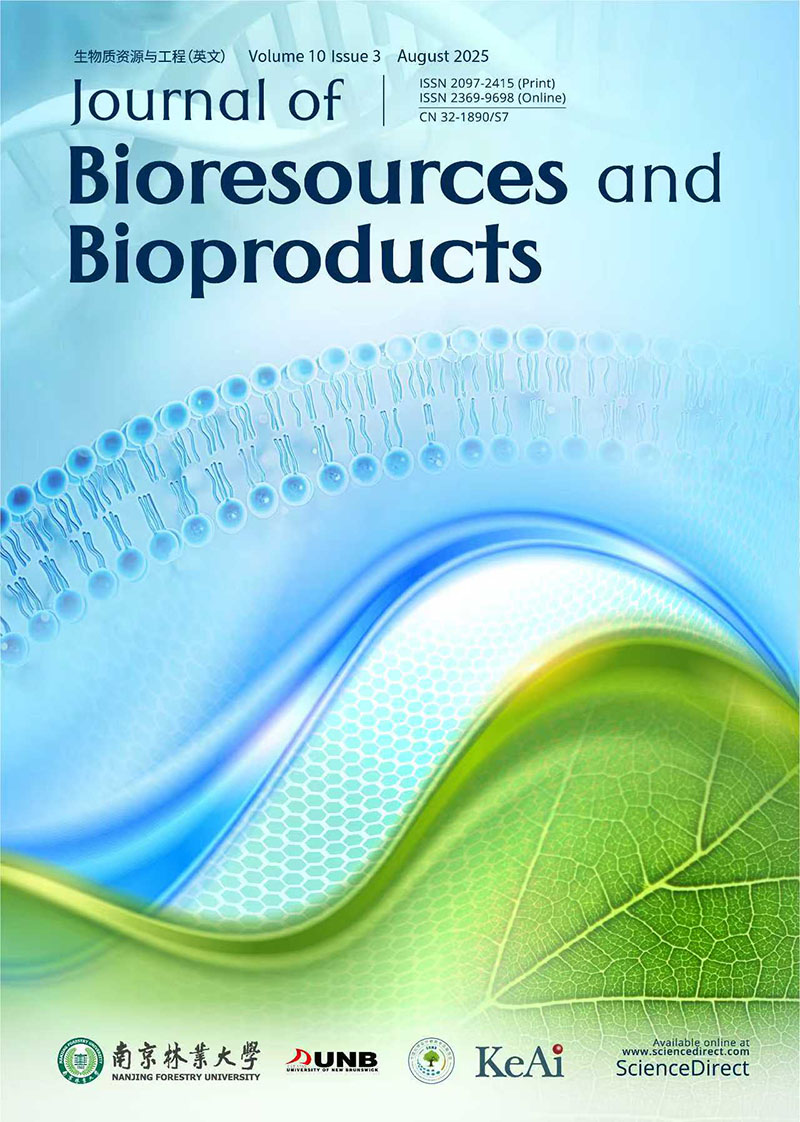2019, Vol. 4, No. 2
The physical, chemical and fibre characteristics of the 6, 8 and 10 years old akashmoni (Acacia auriculiformis) wood from the second generation seed and their suitability for pulping were assessed and compared with the wood of 10 years old from the first generation seed. The A. auriculiformis of 8 years old had the highest α-cellulose and lower lignin than those of 6 and 10 years old, which are similar to the first generation wood. This study also evaluated the effect of cooking time, temperature and active alkali on kraft pulping. The most important influence factors for pulp yield and kappa number were active alkali charge and time. The highest screened rejects were observed for young tree. Delignification degree of the 1st generation was faster than that of the 2nd generation A. auriculiformis.
To valorize kraft lignin, hydroxymethylation and sulfonation were applied on this under-utilized, but vastly available, material. The hydroxymethylation pretreatment was conducted as means to improve the reactivity of lignin. The sulfonation of hydroxymethylated kraft lignin was investigated by sulfuric acid and sodium sulfite treatments under various conditions. The modified lignin samples were characterized for their charge density, solubility, elemental components, and molecular weights. The results showed that the hydroxymethylation facilitated the sulfonation by sodium sulfite, yielding a product (SSH-lignin) with the charge density of -1.2 meq/g and water solubility of 10 g/L under the conditions of H2SO3/lignin molar ratio of 0.49 mol/mol, 95℃ and 3 h. On the other hand, hydroxymethylation hindered the sulfonation of lignin by sulfuric acid, yielding a product (SAH-lignin) with the charge density of -0.46 meq/g and solubility of 0.9 g/L under the conditions of H2SO4/lignin molar ratio of 14.8 mol/mol, 80℃ and 1 h. The SSH-lignin had a high adsorption on kaolinite (17 mg/g) at a lignin concentration of 40 g/L. The sulfonated lignins were also found to be effective coagulant for the cationic dye ethyl violet.
The static test of two single light wood trusses and two girder trusses were carried out to explore the performance enhancement effect of girder trusses and the influence of different connection types on the mechanical behavior, which was studied through the comparison of the test results of four trusses. It is found that the girder trusses can show better load-carrying capacity and anti-deforming ability compared with which simply increases the cross-section size of the members. Because of the advantage of the connection materials and the non-fastening connection mechanism, the wood pin-connected truss has more ultimate bearing capacity which is 2.6 times of single truss, and better deformation resistance which is only 66.2% of the nailed one's creep value.
Waste cooking oil was modified to prepare bio-base plasticizers (a, b and c) with terephthalic acid, adipic acid and benzoic acid by transesterification, epoxidation and ring opening reactions, respectively. The polyvinyl chloride (PVC) films (a/PVC, b/PVC and c/PVC) were prepared using a, b and c as bio-base plasticizers. The epoxidation and ring opening reactions were mainly investigated through GC-MS analysis. The structures of bio-base plasticizers (a, b and c) were confirmed by Fourier transform infrared spectroscopy (FT-IR), 1H NMR and 13C NMR. The mechanical properties of a/PVC were as good as those of PVC films with the dioctyl phthalate (DOP) plasticizer. Meanwhile, the elongation at break of c/PVC reached 422%. The glass transition temperature (Tg) from dynamic mechanical analysis (DMA) was reduced to 30.6℃, 45.3℃, 23.6℃ and 40.6℃, respectively when 40 phr of a, b, c and DOP plasticizer were added. Results of thermogravimetric analysis (TGA) illustrated that the thermal degradation stabilitiy of a/PVC films was better than those of c/PVC and DOP/PVC. The volatility losses of a, b and c were lower than that of the DOP. Bio-base plasticizers a and c exhibited excellent migration resistance in different solutions (distilled water, 50% ethanol (w/w)). The FT-IR of PVC films showed that the downfield shifts of the -CH-Cl groups of the PVC plasticized with a and c were greater than that of b/PVC. The bio-base plasticizers b had a better plasticizing effect at low temperature.
The sound insulation performance is an important technical index for evaluating the physical property of the building wall. Three kinds of structural wood walls integrated with wood plastic composite (WPC) were designed. And the sound insulation performance of the walls was studied. The results showed that for the wall that constructed by the WPC as the wall studs, compared with the one that constructed by the pine wood as the wall studs, the deviation of their sound insulation was lower than ±3 dB. The wall's external panel material had significant effect on the wall's sound insulation property, and the contribution of the wood-plastic panel to the sound insulation was much higher than that of the polyvinyl chloride (PVC) plastic hanging board. The surrounding sealing quality of the wall's external panel material had an important influence on the sound insulation effect of the building wall, and the panel of the wood plastic interior wall had less influence on the sound insulation performance of the wall. Taking the sound-absorbing cotton or non-woven fabric as elastic strips was an effective technical measure to improve the sound insulation performance of the walls. The sound insulation was improved by 2.4 dB and 3.1dB respectively after the correction of pink noise spectrum, and increased by 2.8 dB and 3.6 dB respectively after the correction of traffic noise spectrum.
In order to optimize the out-of-plane compression performance of the wood structure, wood-based 2-D lattice structures were designed and manufactured with oriented strand board as the panel and birch round stick as the core by using a simple insert-glue method. In this experiment, the different thicknesses of the upper and lower panels, the different shavings arrangement directions of the upper and lower panels and the different configurations of the specimens were used to analyze the compression performance of the specimens under multivariable conditions. Through the combination of experimental test and theoretical analysis, we analyzed and compared different failure types of the structure and multiple compression parameters. The results showed that the shavings arrangement direction of the panel has a more important influence on the whole specimen than the thickness of the panel, especially the transverse shavings of the panel can withstand greater shear stress than the longitudinal shavings for a specimen.
Epoxy resins are a group of important materials that have been used everywhere, and development of new materials of this kind with optimal mechanical properties from either bio-resources or industrial precursors has drawn great focus from scientists and engineers. By reacting different kinds of epoxy adhesives and curatives, massive kinds of epoxy resins with different characteristics are produced. Determination of original mixing ratio of epoxy adhesives and corresponding curatives of their curing products is useful in controlling and examining these materials. Here in this work, we described an efficient method based on Raman spectrometry and machine learning algorithms for rapid molar composition determination of epoxy resins. Original mixing ratio of epoxy adhesives and curatives could be calculated simply via Raman spectra of the products. Raman spectral data scanned during curing procedure was fed to random forest (RF) classification to calculate weights of Raman shift features and reduce data dimensionality, then spectral data of selected features were processed by partial least squares regression (PLSR) for model training and composition ratio determination. It turned out that ratio predictions of our model fit well to their actual values, with a coefficient of determination (R2) of 0.9926, and a root mean squared error (RMSE) of 0.0305.






